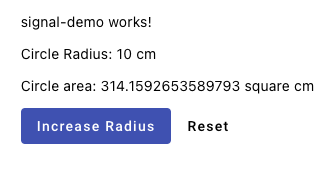Angular Signal Explained
Signals Basics
Angular Signal was introduced in Angular 17. Angular uses signals established a new way of change detection. It uses the observable design pattern. When one code changes the value of a signal, other code that uses the signal will get notified and we can do something in response to the new value. That’s the main advantage to use signals.
-
Writable signals: created by calling the
signal()function with a initial value. -
Computed signals: computed signals are read-only signals that derive their value from other signals.
-
Effect: we can use
effect()to perform some sort of side effect when the signal value changes without modifying the signal. -
Read signal value: need to use
yourSignalVarName() -
Modify signal: need to use
yourSignalVar.set()oryourSignalVar.update()to modify signal value.
In the following example,
-
We create a WritableSignal signal "circleRadius" using
signal(). -
We create a computed signal "circleArea" using
computed(). -
We display them on the UI using
circleRadius()andcircleArea(). -
The "Increase Radius" button will increase the value of the signal by calling
update()function. -
The "Reset" button reset the value of the signal to 0 by calling
set()function. -
We use
effect()to log the circle radius when the signal value changes.
import { Component, computed, signal, effect } from '@angular/core';
import { MatButtonModule } from '@angular/material/button';
@Component({
selector: 'app-signal-demo-1',
standalone: true,
imports: [MatButtonModule],
template: `
<p>Signal Demo 2</p>
<!-- display signal value -->
<p>Circle Radius: {{ circleRadius() }} cm</p>
<!-- display computed signal value -->
<p>Circle area: {{ circleArea() }} square cm</p>
<button mat-flat-button color="primary" (click)="increase()">
Increase Radius
</button>
<button mat-flat-button color="secondary" (click)="reset()">Reset</button>
`,
styles: [],
})
export class SignalDemo1Component {
// create a new signal variable
circleRadius = signal<number>(0);
// create a computed signal variable
circleArea = computed<number>(
() => Math.PI * Math.pow(this.circleRadius(), 2)
);
constructor() {
effect(() => {
// use effect to log signal value when it changes
console.log(`circleRadius changed to ${this.circleRadius()}`);
});
}
increase() {
// Increase the signal value
this.circleRadius.update((v) => v + 1);
}
reset() {
// Set signal value to 0
this.circleRadius.set(0);
}
}

Signal for Objects or Arrays
Angular needs to trigger the notification when the signal value changes. It has no issue with primitive values. But for object or array value, it won’t consider the value changed if we just mutated the content of the object or array.
In the follow code, we manually mutate the john’s age in function mutate1(). We can see that John’s age changed, but the computed signal dad().age does’t change on the UI. That’s because it bypasses the signal system. The manually change of an object’s property won’t trigger the notification. So, we should always use the Signal API set() or update() to modify signals.
import { CommonModule } from '@angular/common';
import { Component, computed, signal } from '@angular/core';
import { MatButtonModule } from '@angular/material/button';
@Component({
selector: 'app-signal-demo-2',
standalone: true,
imports: [CommonModule, MatButtonModule],
template: `
<p>Signal Demo 2</p>
<!-- display signal value -->
<div>{{ john().name }}'s age: {{ john().age }}</div>
<div>{{ dad().name }}'s age: {{ dad().age }}</div>
<br />
<div>
<button mat-flat-button color="primary" (click)="mutate1()">
Modify John's age manually
</button>
</div>
<br />
<div>
<button mat-flat-button color="primary" (click)="mutate2()">
Modify John's age with update()
</button>
</div>
`,
styles: [],
})
export class SignalDemo2Component {
// create a new signal variable
john = signal({ name: 'John', age: 10 });
dad = computed(() => ({ name: 'Dad', age: this.john().age + 25 }));
mutate1() {
// Increase the signal value, but it won't trigger notification.
this.john().age++;
}
mutate2() {
// Increase the signal value using update()
this.john.update((value) => ({ ...value, age: value.age + 1 }));
}
}
Signal Equation
Angular signal API by default uses "===" to check if the signal value changed. Variables of object value or array hold the reference of memory. The reference won’t change if we change the properties of them. So even we use the set() or update(), the notification won’t happen if we mutate the properties of the object or items of the array. It’s a wrong way to use update() in the following example:
// This won't work because the reference doesn't change
this.john.update((value) => {
value.age += 1;
return value;
});
The right solution is to use the spread operator … to create a new instance of the value.
this.john.update((value) => ({ ...value, age: value.age + 1 }));
On the other hand, the following code will always trigger the notification even we set the signal with same value.
// This will trigger the notification ever time it is called.
this.john.set({name: 'John', age: 10});
The solution for this case is to override the equality method when we create a signal like below:
john = signal(
{
name: 'John',
age: 10
},
{
equal: (a, b) => {
return a.name === b.name && a.age === b.age;
}
}
);
mutateJohnAge() {
// The notification won't trigger because the signal's equal method will return true
this.john.set({name: 'John', age: 10});
}
Convert Observable Response to Signal
RxJS Interop is a new API to convert Observable to Signal and vise versa.
-
toSignal: convert Observable to Signal.
-
toObservable: convert Signal to Observable.
Here is the example of using toSignal().
private http = inject(HttpClient);
// create a new signal from Observable.
family = toSignal(this.http.get<Person[]>('http://localhost:3000/family'), {
initialValue: [],
});
john = computed(() => this.family().find((p) => p.name === 'John')!);
dad = computed(() => this.family().find((p) => p.name === 'Dad')!);
toSignal() creates a read-only Signal. You can’t modify it. This is OK if you display the signal value only. But it is a problem if you want to modify it.
To resolve this problem, we can create a WritableSignal with the ready-only signal value. Here is an example:
private http = inject(HttpClient);
// create a new signal from Observable.
readOnlyFamily = toSignal(this.http.get<Person[]>('http://localhost:3000/family'), {
initialValue: [],
});
// create a signal of signal
family = computed(() => signal(this.readOnlyFamily()));
onModifyButtonClick() {
// modify the signal value
this.family().update(p => ({...p, age: 30}));
}